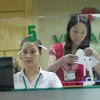Local, foreign paintmakers vie for market
According to the Viet Nam Paint and Printing Ink Association (VNPIA), from 2000 to 2012 the domestic paint sector saw substantial growth, averaging 20 per cent a year.
The growth has led to a rapid increase in the number of paint manufacturers. About 600 companies produce 250 million litres of paint a year. Decorative paint makes up 180 million litres of that amount.
Thanks to favorable policies from the Government, many foreign paint companies have entered the Viet Nam market. Only 10 per cent are high-end brands, but they have a market share of 65 per cent, thanks to advantages in brands and financial capability.
The domestic market is divided into four segments: AkzoNobe, Nippon and Jotun account for 35 per cent of the market share; 4 Oranges, TOA and SeaMaster occupy 25 per cent; and Joton, Kova and Tison 15 per cent. The remaining 25 per cent belong to small companies.
Although 2014 was a year of recovery for the real estate market, purchasing power remains weak.
This has had a major influence on the paint market, with consumption growth decreasing significantly, registering at only 5 per cent.
Because of the sluggish growth of the construction market, the rate was much lower than the 10-12 per cent rates recorded in previous years.
As a result, competition has become stiff and all manufacturers have had to expand their production to avoid losing market share.
Though they hold 65 per cent of market share, foreign manufacturers continue to make higher investments.
In 2014, Nippon built its third factory in the northern Province of Vinh Phuc. In 2013, Joton invested US$16.1 million to increase its plant's production capacity to 25 million litres per year.
Though domestic paint manufacturers have been overshadowed by their foreign counterparts, they have developed specific strategies to protect their market share.
In recent years, local paint brands like Kova, Nero Dong Tam and Hoa Binh have attempted to launch unique product lines.
Nero Paint, for instance, has offered a new waterproof decorative paint, Nero Cement Paint, with quality equivalent to similar foreign products but at a price 30-50 per cent lower.
Hoa Binh Paint has focused on stone paint for the premium segment, with its Hodastone paint. Despite having an average price two to three times higher than water-based paint, it remains popular due to its aesthetic and durable quality for buildings on the coast, where the weather is sunny and windy with salty air, and also for cold climates.
In addition, domestic paint manufacturers have strongly focused on customers at rural areas as the market in major cities is dominated by foreign companies.
Local brands Kova and Tison typify this trend. Though they have been favored more than some foreign brands, they have been mainly distributed in provinces.
Many domestic companies have offered big discounts for investors and contractors, and launched promotion programmes for agents.
The CEO of a domestic paint company, who declined to be named, said that this method had been effective because most consumers were not aware of all of the features of paint products, and could not easily distinguish the level of quality among them.
For this reason, offering high discounts to agents and contractors had helped local paint companies increase their sales revenue, he said.





